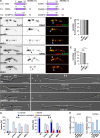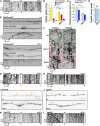The ESCRT regulator Did2 maintains the balance between long-distance endosomal transport and endocytic trafficking
- PMID: 28422978
- PMCID: PMC5415202
- DOI: 10.1371/journal.pgen.1006734
The ESCRT regulator Did2 maintains the balance between long-distance endosomal transport and endocytic trafficking
Abstract
In highly polarised cells, like fungal hyphae, early endosomes function in both endocytosis as well as long-distance transport of various cargo including mRNA and protein complexes. However, knowledge on the crosstalk between these seemingly different trafficking processes is scarce. Here, we demonstrate that the ESCRT regulator Did2 coordinates endosomal transport in fungal hyphae of Ustilago maydis. Loss of Did2 results in defective vacuolar targeting, less processive long-distance transport and abnormal shuttling of early endosomes. Importantly, the late endosomal protein Rab7 and vacuolar protease Prc1 exhibit increased shuttling on these aberrant endosomes suggesting defects in endosomal maturation and identity. Consistently, molecular motors fail to attach efficiently explaining the disturbed processive movement. Furthermore, the endosomal mRNP linker protein Upa1 is hardly present on endosomes resulting in defects in long-distance mRNA transport. In conclusion, the ESCRT regulator Did2 coordinates precise maturation of endosomes and thus provides the correct membrane identity for efficient endosomal long-distance transport.
Conflict of interest statement
The authors have declared that no competing interests exist.
Figures







Similar articles
-
ESCRT Mutant Analysis and Imaging of ESCRT Components in the Model Fungus Ustilago maydis.Methods Mol Biol. 2019;1998:251-271. doi: 10.1007/978-1-4939-9492-2_19. Methods Mol Biol. 2019. PMID: 31250308
-
Did2 coordinates Vps4-mediated dissociation of ESCRT-III from endosomes.J Cell Biol. 2006 Dec 4;175(5):715-20. doi: 10.1083/jcb.200606113. Epub 2006 Nov 27. J Cell Biol. 2006. PMID: 17130288 Free PMC article.
-
Spatiotemporal dynamics of membrane remodeling and fusion proteins during endocytic transport.Mol Biol Cell. 2015 Apr 1;26(7):1357-70. doi: 10.1091/mbc.E14-08-1318. Epub 2015 Feb 5. Mol Biol Cell. 2015. PMID: 25657322 Free PMC article.
-
Integration of the Endocytic System into the Network of Cellular Functions.Prog Mol Subcell Biol. 2018;57:39-63. doi: 10.1007/978-3-319-96704-2_2. Prog Mol Subcell Biol. 2018. PMID: 30097771 Review.
-
ESCRT functions in autophagy and associated disease.Cell Cycle. 2008 May 1;7(9):1166-72. doi: 10.4161/cc.7.9.5784. Epub 2008 Feb 11. Cell Cycle. 2008. PMID: 18418046 Review.
Cited by
-
Linking transport and translation of mRNAs with endosomes and mitochondria.EMBO Rep. 2021 Oct 5;22(10):e52445. doi: 10.15252/embr.202152445. Epub 2021 Aug 17. EMBO Rep. 2021. PMID: 34402186 Free PMC article. Review.
-
The mRNA stability factor Khd4 defines a specific mRNA regulon for membrane trafficking in the pathogen Ustilago maydis.Proc Natl Acad Sci U S A. 2023 Aug 22;120(34):e2301731120. doi: 10.1073/pnas.2301731120. Epub 2023 Aug 17. Proc Natl Acad Sci U S A. 2023. PMID: 37590419 Free PMC article.
-
Red CdSe/ZnS QDs' Intracellular Trafficking and Its Impact on Yeast Polarization and Actin Filament.Cells. 2023 Feb 2;12(3):484. doi: 10.3390/cells12030484. Cells. 2023. PMID: 36766825 Free PMC article.
-
Fungal Morphogenesis, from the Polarized Growth of Hyphae to Complex Reproduction and Infection Structures.Microbiol Mol Biol Rev. 2018 Apr 11;82(2):e00068-17. doi: 10.1128/MMBR.00068-17. Print 2018 Jun. Microbiol Mol Biol Rev. 2018. PMID: 29643171 Free PMC article. Review.
-
The key protein of endosomal mRNP transport Rrm4 binds translational landmark sites of cargo mRNAs.EMBO Rep. 2019 Jan;20(1):e46588. doi: 10.15252/embr.201846588. Epub 2018 Dec 14. EMBO Rep. 2019. PMID: 30552148 Free PMC article.
References
-
- Huotari J, Helenius A. Endosome maturation. EMBO J. 2011;30(17):3481–500. doi: 10.1038/emboj.2011.286 - DOI - PMC - PubMed
-
- Teis D, Saksena S, Emr SD. SnapShot: the ESCRT machinery. Cell. 2009;137(1):182–e1. doi: 10.1016/j.cell.2009.03.027 - DOI - PubMed
-
- Hanson PI, Cashikar A. Multivesicular body morphogenesis. Annu Rev Cell Dev Biol. 2012;28:337–62. doi: 10.1146/annurev-cellbio-092910-154152 - DOI - PubMed
-
- McCullough J, Colf LA, Sundquist WI. Membrane fission reactions of the mammalian ESCRT pathway. Annu Rev Biochem. 2013;82:663–92. doi: 10.1146/annurev-biochem-072909-101058 - DOI - PMC - PubMed
-
- Hurley JH. ESCRTs are everywhere. EMBO J. 2015;34(19):2398–407. doi: 10.15252/embj.201592484 - DOI - PMC - PubMed
MeSH terms
Substances
LinkOut - more resources
Full Text Sources
Other Literature Sources

